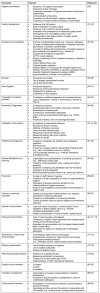Review of indicators for cross-sectoral optimization of nosocomial infection prophylaxis - a perspective from structurally- and process-oriented hygiene
- PMID: 22558049
- PMCID: PMC3334955
- DOI: 10.3205/dgkh000199
Review of indicators for cross-sectoral optimization of nosocomial infection prophylaxis - a perspective from structurally- and process-oriented hygiene
Abstract
In the care of patients, the prevention of nosocomial infections is crucial. For it to be successful, cross-sectoral, interface-oriented hygiene quality management is necessary. The goal is to apply the HACCP (Hazard Assessment and Critical Control Points) concept to hospital hygiene, in order to create a multi-dimensional hygiene control system based on hygiene indicators that will overcome the limitations of a procedurally non-integrated and non-cross-sectoral view of hygiene. Three critical risk dimensions can be identified for the implementation of three-dimensional quality control of hygiene in clinical routine: the constitution of the person concerned, the surrounding physical structures and technical equipment, and the medical procedures. In these dimensions, the establishment of indicators and threshold values enables a comprehensive assessment of hygiene quality. Thus, the cross-sectoral evaluation of the quality of structure, processes and results is decisive for the success of integrated infection prophylaxis.This study lays the foundation for hygiene indicator requirements and develops initial concepts for evaluating quality management in hygiene.
Im Rahmen der gesundheitlichen Betreuung der Patienten ist die Prävention nosokomialer Infektionen ein elementares Anliegen. Für die erfolgreiche Prävention wird ein schnittstellen- und sektorenübergreifendes Qualitätsmanagement der Hygiene benötigt. Zielsetzung ist die Übertragung des HACCP-Konzepts in die Krankenhaushygiene, um auf der Basis von Hygieneindikatoren ein mehrdimensionales Hygienekontrollsystems aufzubauen, dass die Limitierungen einer nicht prozessual integrierten und nicht schnittstellenübergreifenden Betrachtung der Hygiene überwindet.
Für die Umsetzung des dreidimensionalen Qualitätssicherung der Hygiene im Klinikbetrieb sind drei entscheidende Risikodimensionen identifizierbar: die Konstitution der Menschen, die baulich-technische Umgebung inklusive Medien und die medizinischen Prozesse. In diesen Dimensionen ermöglicht die Festlegung von Indikatoren und Grenzwerten eine gesamthafte Bewertung der Hygienequalität. Entscheidend für den Erfolg der Infektionsprävention ist daher die ineinandergreifende Bewertung der Struktur-, Prozess- und Ergebnisqualität.
Mit dieser Zielsetzung werden Anforderungen an Hygieneindikatoren begründet und erste Vorstellungen zur Bewertung eines Qualitätsmanagement der Hygiene entwickelt.
Keywords: hygiene indicators; hygiene quality management; multi-dimensional hygiene control system; outcome quality; prevention of nosocomial infections; process quality; structural quality.
Figures






Similar articles
-
[Practice of nosocomial infection management in burn department based on the American hospital evaluation standard of the Joint Commission International].Zhonghua Shao Shang Za Zhi. 2020 Jun 20;36(6):488-492. doi: 10.3760/cma.j.cn501120-20190206-00020. Zhonghua Shao Shang Za Zhi. 2020. PMID: 32594709 Chinese.
-
Development of indicators for a nationwide cross-sectoral quality assurance procedure for mental health care of patients with schizophrenia, schizotypal and delusional disorders in Germany.Z Evid Fortbild Qual Gesundhwes. 2017 Oct;126:13-22. doi: 10.1016/j.zefq.2017.07.006. Epub 2017 Oct 11. Z Evid Fortbild Qual Gesundhwes. 2017. PMID: 29029972
-
Potential of innovations in hygiene management - a managerial perspective.Antimicrob Resist Infect Control. 2019 Jun 14;8:100. doi: 10.1186/s13756-019-0555-x. eCollection 2019. Antimicrob Resist Infect Control. 2019. PMID: 31249682 Free PMC article.
-
[Infection control and hygiene management in equine hospitals].Berl Munch Tierarztl Wochenschr. 2014 Nov-Dec;127(11-12):486-97. Berl Munch Tierarztl Wochenschr. 2014. PMID: 25872258 Review. German.
-
[Hygiene barriers in the hospital--instrumentation aspects].Zentralbl Hyg Umweltmed. 1991 Mar;191(2-3):171-81. Zentralbl Hyg Umweltmed. 1991. PMID: 2059281 Review. German.
References
-
- Korczak D, Schöffmann C. Medical and health economic evaluation of prevention- and control measures related to MRSA infections or -colonisations at hospitals. GMS Health Technol Assess. 2010 Mar 16;6:Doc04. doi: 10.3205/hta000082. Available from: http://dx.doi.org/10.3205/hta000082. - DOI - DOI - PMC - PubMed
-
- Anderson J, Gosbee LL, Bessesen M, Williams L. Using human factors engineering to improve the effectiveness of infection prevention and control. Crit Care Med. 2010 Aug;38(8 Suppl):S269–S281. doi: 10.1097/CCM.0b013e3181e6a058. Available from: http://dx.doi.org/10.1097/CCM.0b013e3181e6a058. - DOI - DOI - PubMed
-
- Bundesministerium für Gesundheit. Pressemitteilung: Gesetz zur Änderung des Infektionsschutzgesetzes und weiterer Gesetze passiert Bundesrat. Berlin; 8. Juli 2011. Available from: http://www.bmg.bund.de/ministerium/presse/pressemitteilungen/2011-03/inf....
-
- Gesetz zur Änderung des Infektionsschutzgesetzes und weiterer Gesetze vom 28. Juli 2011. Bundesgesetzblatt. 2011 Aug 3;Teil I(Nr. 41):1622–1630.
LinkOut - more resources
Full Text Sources

